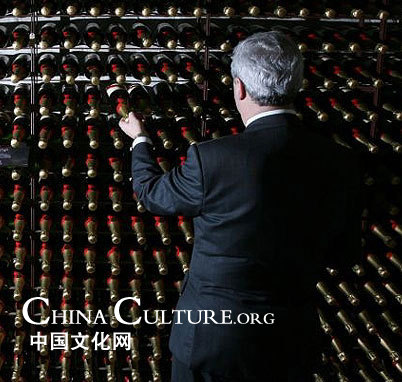Chinese Way
Uncorking history
Updated: 2008-11-11 09:48
By Zhao Xu (chinaculture.org)
Four years of assiduous work and around HK$30 million later, the place was transformed into its current incarnation.
 |
|
|
Today, the cellar occupies four of the original 12 pairs of bunkers. Three pairs are used for wine-cellaring while the other makes up the underground part of what's known as the Crown Wine Cellars clubhouse.
"It's like an American goldmine - the deeper you walk into the mountain, the higher it rises above you," says De'eb, before he dives underground.
The highest point corresponds with the innermost part of the clubhouse - the far end of the historic tunnel that lies 20 m below the ground and is beguilingly called "The Library".
It's a place to have conversation and to think - as the dimly-lit, history-imbued area induces in both intimacy and sobriety.
On the solid oak table, half-burnt candles are placed alongside about-to-bloom red roses and chrysanthemums. Under one roof, things are heading in two different directions - beautiful demise and brilliant rebirth. What else could be said of this place?
The most powerful reminder of history is the inner wall separating the two sister bunkers that make up the Library and the adjoining underground Main Reception Room. It is composed of one-inch outside brick, one-inch hollow space and one meter of solid concrete.
The purpose of the hollow space is to serve as a cushion in case an explosion occurs inside the bunker and pushes one wall against the other.
By retaining the original hard floors and walls, De'eb, who's a fan of the early-twentieth-century Bauhaus style, has embraced the soul of the building without losing his own design soul.
"I want people to see the wall, feel the hard floor," he says. "The rough feeling resulting from its old days as an ammunition depot translates easily into a minimalist, industrial style which I'm fond of."
However, you are wrong to think that any time spent inside the cellar is bound to be an entangled affair with the past. The journey ends in the light-flooded space above the ground, called "The Conservatory".
Connected directly to the underground Main Reception Room by a tunnel approximately 12 m, the Conservatory is as airy and atmospheric as the underground space is romantic and ruminative. (The tunnel, by the way, has one turn that could deflect and reduce the impact of a blast should an explosion happen inside the bunker.)
Everything here is painted white, except for the red roses ablaze against the pristine background. The huge pipes used for air ventilation are painted white and deliberately exposed, to convey the same sense of arty edginess.
De'eb has also voted against re-waxing the hard-scratched floor because he doesn't want to "obliterate its past".
On the day of my visit, workers walk gingerly on the Conservatory's one-inch-think glass roof to clean it. From where they stand, The Conservatory must look like a giant jewel box, a carefully-kept contemporary secret.
On January 15 this year, the site was given a UNESCO Asia-Pacific Heritage Award of Merit, which recognizes it as a "vibrant, living project". Mr Arthus Gomes, one of the last surviving foreign soldiers to have defended Hong Kong in 1941, wrote a recommendation letter to UNESCO on March 15, 2007, six days before he died.
"Long after we all die, and the company moves to another place, the building will still be here," De'eb muses. "It will be handed down to the next generation and become part of their shared experience."
It's that acute sense of mortality, viewed through the infinity of time, that permeates the space.
"This place represents Hong Kong perfectly. It keeps our memories alive," he says.
Specials

President Hu visits the US
President Hu Jintao is on a state visit to the US from Jan 18 to 21.

Ancient life
The discovery of the fossile of a female pterosaur nicknamed as Mrs T and her un-laid egg are shedding new light on ancient mysteries.

Economic Figures
China's GDP growth jumped 10.3 percent year-on-year in 2010, boosted by a faster-than-expected 9.8 percent expansion in the fourth quarter.